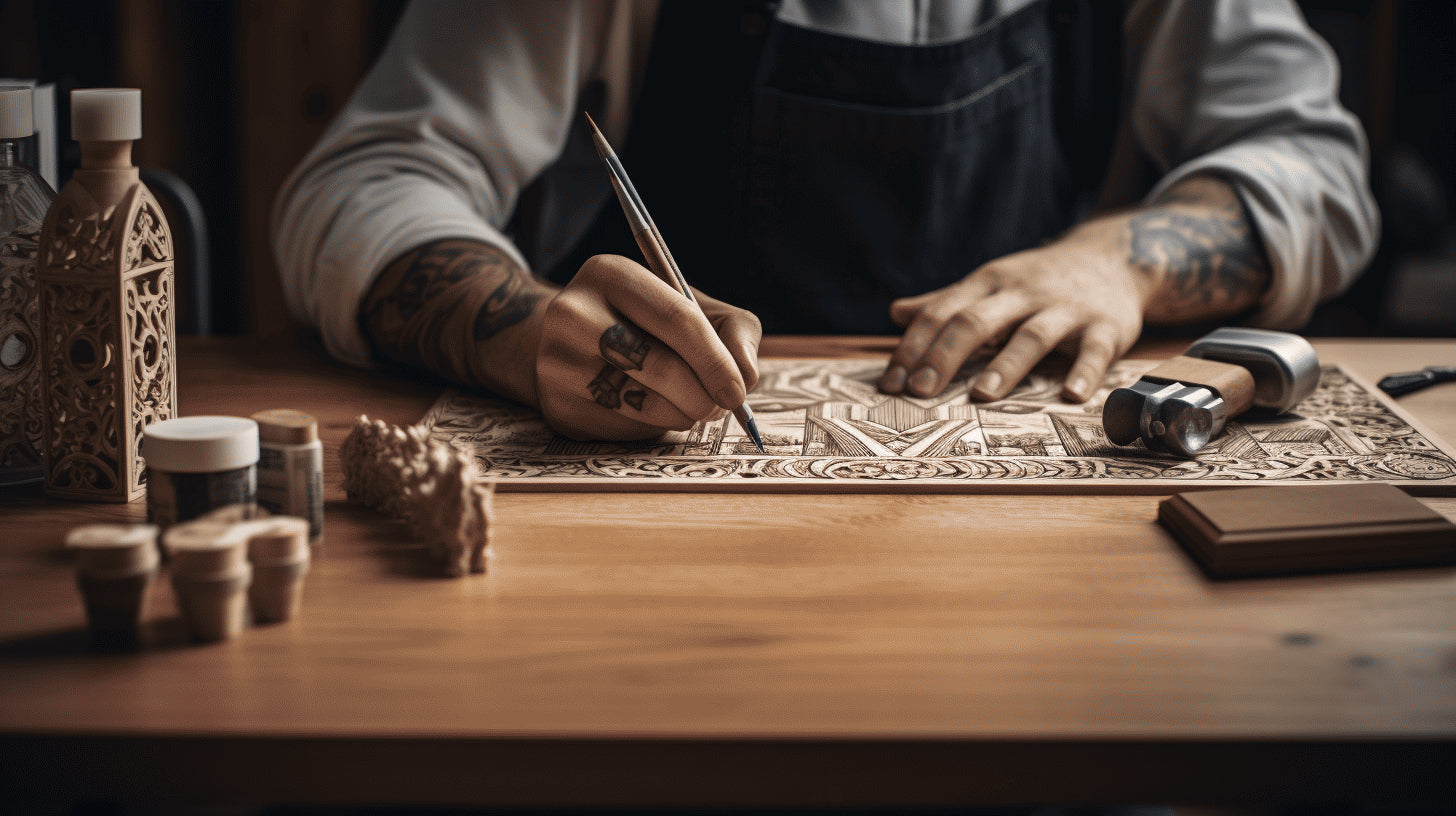
The Beauty of Handmade: Unveiling the Artistry Behind Every Stroke
Handmade products possess a unique charm that resonates with individuals all around the world. Whether it's a beautifully crafted piece of pottery, a hand-knit sweater, or an intricately woven basket, there is something captivating about owning an item that has been lovingly created by hand. In a world dominated by mass production and uniformity, handmade products stand as a testament to the artistry and creativity of skilled artisans.
From ancient civilizations to modern times, the art of crafting by hand has been a vital part of human culture and history. It not only serves as a means of creative expression but also allows us to connect with our roots and appreciate the nuances of traditional techniques passed down through generations.
In this article, we will delve into the world of handmade products and explore the diverse range of craftsmanship that exists across different cultures. We will uncover the expanding global arts and crafts market, the rise of the handicrafts industry, and the profound influence of handcrafting in Indian history. So, join us on this journey as we unveil the artistry behind every stroke and discover the beauty of handmade.
Expanding Global Arts and Crafts Market
The global arts and crafts market has been experiencing significant growth in recent years. People from all walks of life are embracing the joy and satisfaction of creating something beautiful with their own hands. Whether it's painting, sewing, woodworking, or any other form of artistic expression, arts and crafts have become a popular pastime worldwide.
Estimated Market Revenue
According to industry analysts, the global arts and crafts market is expected to reach a staggering USD 63,590 million by 2028[1](https://www.grandviewresearch.com/industry-analysis/arts-crafts-market). This substantial growth can be attributed to several factors, including the increasing popularity of DIY projects, the rising demand for unique and personalized gifts, and the growing awareness of the therapeutic benefits of engaging in artistic activities.
This surge in market revenue signifies the tremendous potential and opportunities in the arts and crafts industry. Artists, crafters, and creative entrepreneurs can tap into this expanding market to showcase their talents and turn their passion into a profitable business venture.
Rise in Arts and Crafts as a Hobby
Not only is arts and crafts gaining traction in the business world, but it is also becoming a beloved hobby for individuals of all ages. Research shows that roughly a quarter of respondents in the United States reported arts and crafts as their preferred hobby[2](https://www.prnewswire.com/news-releases/25-9-million-us-adults-15-9-percent-practice-arts-and-crafts-annually-new-research-shows-300156237.html).
Engaging in arts and crafts activities provides a multitude of benefits beyond the sheer pleasure of creating something unique. It allows individuals to unleash their creativity, reduce stress, improve focus and concentration, and boost self-esteem. Arts and crafts also offer a platform for self-expression, experimentation, and personal growth.
There is a growing interest in learning and honing artistic skills, with people seeking out workshops, online tutorials, and community classes to develop their craftsmanship. This trend further contributes to the growth of the global arts and crafts market, creating a thriving ecosystem for both hobbyists and professionals.
In conclusion, the expanding global arts and crafts market presents a promising landscape for businesses and individuals alike. With the projected market revenue reaching unprecedented heights and the rise in arts and crafts as a popular hobby, there has never been a better time to explore the boundless possibilities of this creative industry.
The Rise of Handicrafts Market
The handicrafts market has been experiencing a significant rise in popularity and demand in recent years. People from all walks of life are drawn to the charm and uniqueness of handmade products. Whether it's a beautifully carved wooden pen, a hand-woven textile, or a meticulously crafted piece of pottery, these items add a touch of artistry and individuality to our lives.
Market Size Growth
The handicraft market has seen remarkable growth and is projected to continue expanding in the coming years. According to industry reports, the market size was valued at a staggering USD 683.6 billion in 2022. It is estimated that by 2030, the market will reach a remarkable USD 1,578.1 billion, growing at a compounded annual growth rate (CAGR) of 10.8% from 2023.
This growth can be attributed to various factors, including an increasing appreciation for unique and personalized products, rising consumer interest in supporting local artisans and small businesses, and a growing trend towards sustainability and eco-friendly alternatives. Handicrafts offer a tangible connection to tradition and culture, making them highly desirable in an increasingly homogenized and mass-produced world.
Historical Significance
The practice of creating handmade crafts dates back thousands of years and holds immense historical significance. It is fascinating to think that the earliest evidence of handmade crafts can be traced all the way back to the Stone Age, where our ancestors used their creativity and skills to fashion tools, weapons, and decorative objects.
During the late Victorian period in England, the Arts and Crafts movement emerged as a reaction to the industrialization and mass production of goods. This movement emphasized the value of craftsmanship, promoting the idea that handmade objects possessed an inherent beauty and integrity that machine-made items lacked.
Handmade art not only showcases the talent and craftsmanship of the artist but also tells a story. Each piece holds within it the maker's unique perspective, cultural heritage, and creative expression. By owning a piece of handicraft, we become custodians of these stories and play a part in preserving traditions and cultural heritage.
In conclusion, the handicraft market is on a rapid rise, driven by the appreciation for unique, personalized, and sustainably made products. The market size is expected to reach unprecedented heights in the next decade. Handmade crafts not only have historical significance but also offer a way to connect with tradition, culture, and the craftsmanship of artisans worldwide. So, whether you're in search of a one-of-a-kind item or want to support local artisans, the world of handicrafts has something to offer everyone.
The Influence of Handcrafting in Indian History
Indian history is deeply entwined with the art of handcrafting, showcasing a rich heritage that spans centuries. The intricate craftsmanship, attention to detail, and cultural significance of handcrafted items have made them an integral part of Indian identity. From textiles to pottery to jewelry, handcrafting has left an indelible mark on Indian culture. So, let's dive deeper into the influence of handcrafting in Indian history.
Deep Roots in Indian History
Handcrafting in India can be traced back to ancient civilizations such as the Indus Valley Civilization, which thrived around 2500 BCE. The people of this civilization were skilled in pottery, metalwork, and textile production, creating a foundation for future generations to build upon. Throughout the centuries, various dynasties and rulers have contributed to the growth and development of handcrafting in India, creating a diverse range of art forms.
One of the most significant influences on Indian handcrafting was the Mughal Empire, which ruled over a vast part of the Indian subcontinent from the 16th to the 19th century. The Mughals brought with them a sophisticated sense of aesthetics and craftsmanship, blending their own artistic traditions with indigenous Indian styles. This fusion resulted in the creation of breathtakingly beautiful items such as intricate carpets, delicate textiles, and exquisite jewelry.
Impact of Islamic World in Craftsmanship
The Islamic world also left an indelible mark on Indian handcrafting. With the arrival of the Islamic rulers, craftsmanship flourished, reflecting the blend of Indo-Islamic cultures. The art of calligraphy, in particular, became highly revered, with beautiful Arabic scripts adorning religious texts, architecture, and even pottery. Islamic influences can also be seen in the art of minakari (enameling) and zardozi (embroidery with metal thread), which continue to be practiced to this day.
Artistry and Symbolism
Handcrafted items in India go beyond mere aesthetics; they are imbued with deep symbolism and cultural significance. Each stroke, each thread, and each bead tells a tale of tradition, history, and spirituality. The spirituality of handcrafting is evident in the creation of religious artifacts, such as intricately carved wooden sculptures of deities or vibrant paintings depicting mythological scenes. These items not only serve as objects of devotion but also as testaments to the artistic skills passed down through generations.
Preserving Heritage and Empowering Artisans
The influence of handcrafting in Indian history is not just a relic of the past; it continues to thrive in the present day. Handcrafted items from India are coveted around the world for their unique beauty and cultural significance. This demand has created a platform for artisans, empowering them economically and helping preserve traditional craft forms that might otherwise fade away.
By supporting handcrafted goods, individuals contribute to the sustainability of Indian craftsmanship and the livelihood of artisans. Moreover, they become part of a larger narrative that celebrates the beauty, creativity, and resilience of Indian handcrafting.
In conclusion, the influence of handcrafting in Indian history is a testament to the rich heritage and cultural significance of this art form. From the ancient civilizations to the Islamic rule, handcrafting has played a vital role in shaping Indian culture and identity. Today, it continues to thrive, carrying forward centuries-old traditions and empowering artisans. So, let's cherish these handmade treasures and appreciate the artistry behind every stroke.
Frequently Asked Questions
-
What is the significance of handmade products?
Handmade products hold great significance as they are crafted with meticulous care and attention to detail. They often carry a sense of uniqueness, quality, and authenticity that mass-produced items may lack.
-
Why are handmade products often more expensive?
Handmade products are often more expensive due to the time, effort, and skill that goes into creating them. Artisans and craftsmen invest their expertise, using high-quality materials, resulting in the creation of one-of-a-kind pieces that command a higher price.
-
What sets handmade products apart from mass-produced items?
Handmade products are distinguishable from mass-produced items through their individuality and personal touch. Each handmade item is unique, reflecting the creativity and style of the artisan, while mass-produced items lack the same level of artistry and character.
-
Can handmade products be customizable?
Yes, one of the beauties of handmade products is the potential for customization. Many artisans offer personalized options, allowing customers to request specific colors, patterns, or details, making each piece even more special and tailored to individual preferences.
-
How can I support artisans and their handmade creations?
To support artisans and their handmade creations, you can purchase their products directly from them, attend local craft fairs or markets, share their work on social media, or leave positive reviews and recommendations. Your support helps preserve traditional crafts and sustains the artistry behind handmade products.







Leave a comment
This site is protected by hCaptcha and the hCaptcha Privacy Policy and Terms of Service apply.